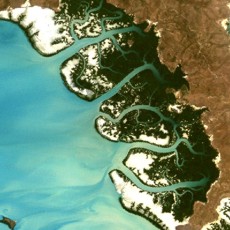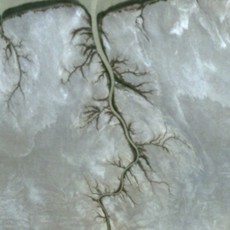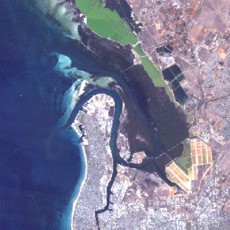Also known as: tidal channels, mangrove creeks, macrotidal mud flats.
Conceptual model diagrams of tidal creeks

Sedimentary Environments (Habitats)
Hydrology
Sediment Transport
Nitrogen Dynamics
Key features of tidal creeks
- A diverse range of both marine and brackish, subtidal, intertidal and supratidal estuarine habitats are supported. Intertidal and supratidal areas are often extensive, whereas turbidity may preclude seagrasses in some areas.
- Large entrance promotes efficient marine flushing.
- River flow is intermittent to non-existent. Flooding is therefore uncommon, however, the effects of any floods are buffered by the large water area and high tidal exchange.
- Turbidity is naturally high due to strong turbulence induced by tides.
- Flanking environments such as intertidal flats, mangroves, saltmarshes and saltflats tend to trap sediment and pollutants. Marine flushing results in loss of some material to the coastal ocean.
- Tidal movement over flanking environments encourages the trapping and processing (e.g. denitrification) of nutrient loads. Marine flushing results in loss of some material to the coastal ocean.
- Evolution, in terms of infilling, is driven by trapping of marine sediment, which results in the gradual expansion of flanking environments and seaward progradation.
Tidal creeks are wide, funnel-shaped coastal waterways, that have very low (or negligible) freshwater input, and typically develop in low-gradient, seaward-sloping coastal flats (Dalrymple, 1992, Semeniuk, 1996, Semeniuk, 1982, Semeniuk et al., 1982). Tidal creeks are the most common type of coastal waterway in Australia, and are most abundant in north-western Australia and the Gulf of Carpentaria, where they occur along mostly macrotidal, low-gradient coastal plains. Due to the overwhelming influence of tidal currents in these systems
Geomorphology
The geomorphology of tidal creeks is usually comprised of a straight, sinuous, or dendritic tidal channel(s) that taper (in a negative-exponential fashion upstream) and shoal to landward (Wolanski et al., 1992). The coastal mudflats that generally surround tidal creeks tend to be at or above the limit of high tide, and seawater is mainly confined to the tidal channel, except during spring tides. Because of their relatively small size, and low freshwater input, they lack the major structural elements such as tidal sand banks that are characteristic of tide-dominated estuaries and deltas. Tidal channels are frequently interconnected, and flanked by large areas of low-gradient intertidal flats, mangroves, saltmarsh, and saltflat environments (Wells, 1995).
The outline of tidal creeks may partially follow the irregular outline of the drowned bedrock embayments in which they have developed (Riggs et al., 1995), or may be smooth and funnel-shaped, sometimes intersected by smaller creek networks (Wells, 1995). Tidal creeks are highly variable in size (Heap et al., 2001) and, due to strong tidal currents generated by large tidal ranges, are usually highly turbid. Tidal creeks are generally distinguished by relatively high tidal energy throughout the system. However, frictional forces reduce tidal energy to landward, and in some of the more tapered systems, amplification of the tidal wave occurs to locally to elevate water levels inside the system and on the surrounding intertidal flats (Dalrymple et al., 1992).



Figure 1. Examples of tidal creeks: Ilamaryi River (NT), Morning Inlet (QLD), and Barker Inlet (SA).
Evolution
The evolution of tidal creeks is characterised by slow progradation and seaward translation of the tidal channel and surrounding intertidal flats, which is driven mostly by landward transport of marine sediment (Belperio, 1993, Woodroffe, 1992). Because of the low freshwater input, the system does not usually contain an alluvial floodplain, and remains bounded by intertidal environments, even in the most mature cases (Boyd et al., 1992, Green et al., 2001, Fitzgerald et al., 2000). Marine sediment moves into tidal creeks by shoreward-directed bedload transport, and infilling occurs as the channel shoals, and the intertidal flats merge (Harris, 1988, Knighton et al., 1992).
Habitats and ecology
Tidal creeks provide habitats, such as channel sands, intertidal mudflats, mangroves, saltmarshes, saltflat flats and rocky shores and rocky reefs in some areas (Semeniuk, 1996, Semeniuk, 1982, Semeniuk et al., 1982, Barnett et al., 1997). These habitats typically support marine species, including transient visitors and permanent residents, however the biota of these waterways is less well documented than their wave dominated counterparts (Connolly et al., 2000, Dalrymple et al., 1992). Plant productivity seems to increase with increasing tidal range, due to greater rates of flushing and the consequent renewal of nutrients (Morrisey, 1995). Littoral mangrove forests dominate many of Australia’s tide-dominated coasts, and plains vegetated with grasses, sedges and herbs, as well as freshwater wetlands and floodplain vegetation (such as Melaleuca spp.) lie above the influence of most tides. Turbid water within the channels largely precludes the growth of subaquatic benthic macrophytes (such as seagrasses), and also limits the distribution and depth range available as habitat for phytoplankton. These species are able to survive further seaward due to lower turbidity (Semeniuk, 1996).


